In this modern life there seems to be little opportunity for use of our hands and forearms. Tennis and the other racket sports are just about the limit as far as using the limbs. This is in sharp contrast to the lives of our fathers who, as farmers, sailors and woodsmen used their hands constantly. Is it any wonder then, that almost everyone who takes up the sword develops what is commonly known as "tennis elbow". This problem comes from straining the muscles in the forearm which move the hand at the wrist. Modern sword students simply don't have the forearm development to jump straight into intense practice.
One way to avoid these problems is to begin practice with a light bokuto and move to a heavier one as the strength increases. This is hard for an enthusiastic beginner who wants to use a heavy blade as soon as the shoulders are strong enough to swing it properly. Swinging is of course easy, it is stopping the blade that causes the forearm damage.
Another way to avoid straining these muscles is to strengthen them before they are damaged. Some specific exercises designed for this are presented here so that students can develop "popeye arms". The tool used is called a tanren bo or sometimes a tanden bo but a bokuto, jo, or metal bar can also be used.
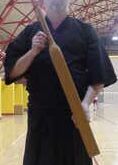
These exercises and repetitions are suggestions only, you may pick and choose amongst them. If you decide to make up some new exercises, please be careful. There are some movements which can do damage to your wrists that will not show up for a couple of days. The tendons get a little irritated and swell up causing pain. Rest and ice usually works for this.
The first stance is a bit of a warm-up in that you stand naturally, your feet at about shoulder width and facing squarely to the front. Don't lock the knees and don't bend them too much either. Keep the muscles of the front and the back of the thighs about equally involved in holding yourself up. This is a very relaxed and safe way of standing which allows you to drop your feeling of balance down into your hips and below.
The other two stances are a migi and hidari gamae. The stance should be long enough that when you drop down onto the back knee, your legs are at 90 degree angles at the knees. You may move into a longer stance than this to put some stress on the legs and to stretch the calf muscles out as you work, no sense wasting time exercising only one part of the body.

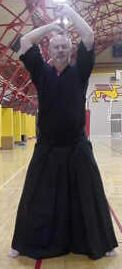
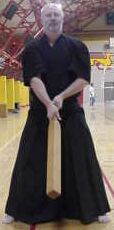
2. Now do about 30 more at the same speed or slightly faster without releasing tenouchi at the top and without swinging past horizontal on the downstroke. As you perform the downstroke sink the hips deeply so that you are at the lowest point as you finish the stroke. Warmup swings = 60 cuts
First stance
3. Move the feet in to shoulder width and move on to proper kiri otoshi. Cut two handed and let the hips drop slightly with each downstroke, don't exaggerate the drop but keep the feeling of cutting with the hara and not the shoulders. Reps = 10
4. Single handed cuts are done with the left then the right hand so that the right hand is tired and the left fresh as you do the final two handed set. This encourages striking with the left hand.
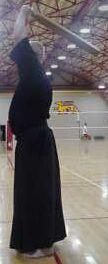
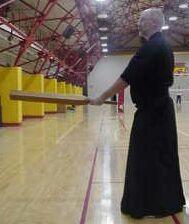
Choke up on the handle and swing using proper grip and motion with the left hand only. Pay particular attention to moving the blade in a vertical plane, don't let the tip swing around. If your hand is not wrung inward over the tsuka properly than you cannot stop the downswing at the horizontal position when using the heavy tanren bo. Be sure to squeeze the little fingers tightly. Beware of letting the index finger be moved sideways as you try to stop the swing, this is very irritating and can give problems in the joint at the base of the finger. Keep the proper shibori position. Reps = 10
5. Switch the tanren bo to the right hand and do 10 more cuts. If you are right handed this will be easier than swinging with the left hand. Resist the temptation to use more resistance for the right arm than for the left. You are trying to balance the strengths so that you use the left hand to cut when using both hands.
6. Now place the left hand back on the tsuka and do 10 more two handed cuts with proper form. As you go through the exercises you must use more and more concentration to keep your form correct since your muscles will be getting fatigued and sloppy.
Migi gamae
7. Without pausing step forward into a right stance, as long and low as you can get and remove the right hand. Pay attention to your knees, you don't want to strain them while exercising the arms. Swing 10 times with the left hand alone.
8. Right hand alone, 10 reps.
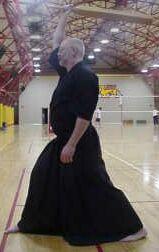
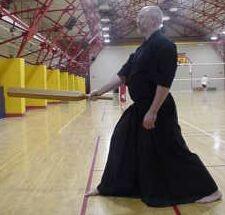
9. Both hands, 10 reps. When both hands are again used it is a temptation to swing a lot harder. This is because it feels so much better to use both hands again. Instead of swinging harder with two hands, work on the single hand cuts so that they feel natural as well.
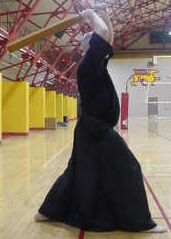

Hidari gamae
10. Left hand, 10 reps.
11. Right hand, 10 reps.
12. Both hands, 10 reps.
This gives a total of 100 cuts per cycle for the three stances. It is best to stop at one cycle if going on to the wrist exercises.
Instead of kiri otoshi, you could choose kesa giri or some other cut for the exercises. Be very careful since all of the other cuts introduce a twisting motion into the exercise that can result in pulled muscles in the neck and back.
An interesting exercise is to switch your hand positions for the two handed cuts so that the right hand is below the left. This will completely destroy your technique, laugh rather than get frustrated when it does, and have some sympathy for beginners who feel this way all the time.
1. With the feet shoulder width apart choke up on the handle with the left hand and stretch the arm straight out in front of yourself. The arm should be at shoulder height, keep it straight to avoid using any extraneous muscles and keep the shoulder down so that there is no tension in the neck.
Point the tip of the tanren bo straight forward, then using the muscles on the top of the forearm raise it in the vertical plane to a vertical position. If you are using the proper grip on the tsuka then you will be exercising the same muscle that will give "tennis elbow". Try to keep the index finger out of the movement or you will irritate the base joint. Reps = 10.
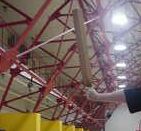

2. Switch hands and do 10 lifts with the right hand. This exercise is especially important since it is the top of the right forearm that is involved in controlling the blade as a cut is stopped. This jerking to a stop is irritating to the ligaments and tendons at the right elbow.
It is possible to do these lifts with two hands but this may encourage a "levering" action in the tsuka which should be avoided in the actual cuts.
Migi gamae
3. Left hand, 10 reps.
4. Right hand, 10 reps. In this position it is easy to let the upper body swing and the shoulders come out of square to the front. Concentrate on proper form, keeping the hips and shoulders square to the front.
Hidari gamae
5. Left hand, 10 reps.
6. Right hand, 10 reps.
This will give thirty reps on each forearm per cycle. With a tanren bo, one cycle is plenty.
Hold the tanren bo in a proper grip with the left hand out in front of yourself. Now switch the tsuka around so that the tanren bo is coming out of the little finger edge of your hand. This is the grip used when doing these exercises standing up.
Straighten the arm down by the side and then move it back as far as possible keeping it straight. This should isolate the forearm muscles as well as working the backs of the shoulders a bit.
First stance
1. Left hand. Keeping proper tenouchi at all times, move the tip of the tanren bo in a vertical plane as far up and down as possible. Do this slowly isolating the proper muscles and without losing control. A mirror will help make sure the movement is vertical and not swinging out to the sides. Reps = 10.
2. Right hand, 10 reps.
Migi hanmi
3 and 4. Left and right hand, 10 reps.
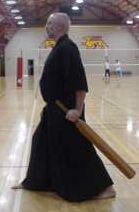
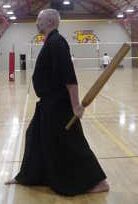
Hidari hanmi
5 and 6. Left and right hand, 10 reps.
Thirty reps each forearm each cycle.
Take a normal grip again as if doing the first wrist exercise. Hold the tanren bo vertically in the left hand with the left arm stretched out straight from the shoulder. Carefully allow the tanren bo to move down to the side until it is horizontal, then move it back up and over to the other side, horizontal again. Once down on both sides is one rep.
If you feel something starting to give way in the wrist or the elbow, drop the tanren bo, don't try to control it. A way to reduce the resistance is to move the tip more toward the front, shortening the (twisting) leverage of the bo on your wrist.
As in the exercises above, three stances and two hands equal six exercises. For this twist 5 reps in each exercise is usually enough. Total twists = 15 each arm.
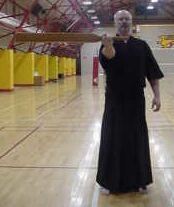
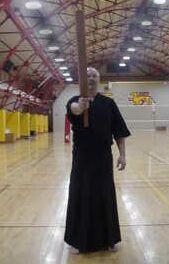

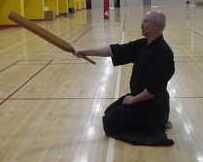
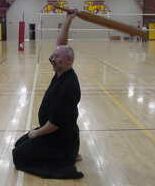
The only exercise that cannot be done easily from seiza is the lower forearm lift. These can be done by holding the tanren bo in a normal grip, raising it to jodan and moving the tip vertically down the back and up again. Try to get a 180 degree arc without releasing tenouchi. To prevent the use of the triceps when moving the stick, use your free hand to hold the elbow and check that the arm stays straight.

1. With a normal grip hold the tanren bo out at arms length. If the wrists are too fatigued to hold it up, prop the end of the tsuka under your forearm to help hold it out horizontally. This will give the forearms a good stretch. Slowly move the arm out to the side and back again to the front. Ten reps each arm.
2. Stand with your side against a wall, the tanren bo in the other hand. Now lift it slowly up to a horizontal position keeping the arm straight. Ten reps both arms.
3. and 4. Repeat the same lifts with the arms angled at 45 degrees to the front and straight out to the front. Use the wall to stop leaning backward, isolating the deltoids. Reps = 10.
5. Move the arms in slow circles to the front and the back. Move slowly so that you are not swinging freely but are controlling the motion at all times with the shoulders. Ten circles each way, both arms.
A good exercise to loosen the wrists and the hips is as follows. Stand with your feet spread about two shoulder widths facing square to the front. Hold the bo as if you have just struck nage on the head, now, using an uke nagashi type motion release the bo and let it swing down toward your body. Don't release the correct grip on the tsuka but move your body to one side so that your wrists can bend with the motion and the bo misses your hip. Let it swing up again behind your head as you re-centre and re-square your body to cut again to head height. After stopping the bo let it drop on the other side.
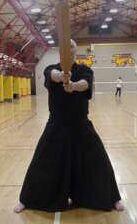
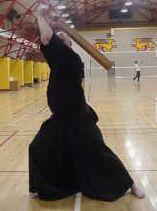
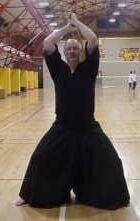

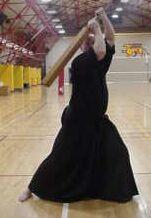
The same movements can be done while walking forward as if in uke nagashi to examine what is happening with your hips and shoulders as you move. Use the weight and momentum of the tanren bo to examine technique while you are loosening the wrists.
If you try these exercises remember to keep good tenouchi and shibori. Isolate the desired muscles and do the movements slowly. Concentrate on your tanden at all times, not on the arm or shoulder strength, it is, after all called a tanden bo.
And where can you get a tanren bo? Try SDKsupplies we've often got some in stock if not, Kim can make you one, .